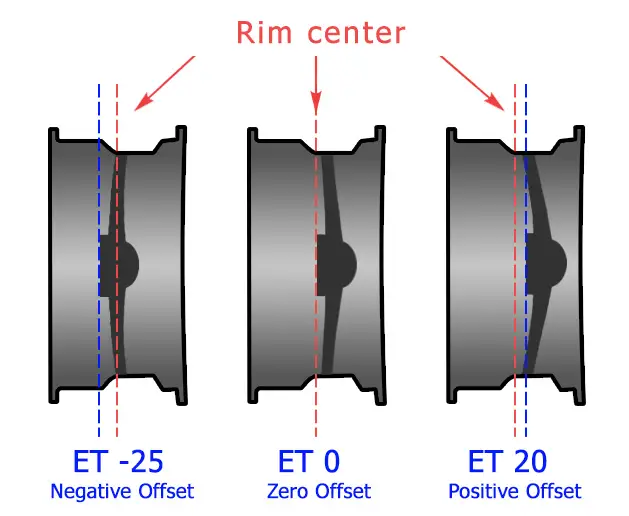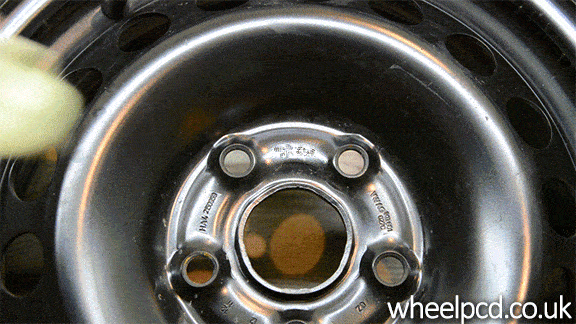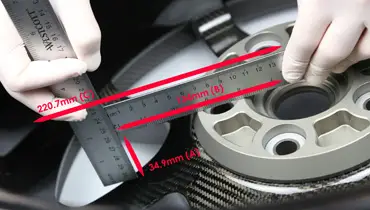Wheel ET Explained
You will notice ET markings stamped into the surface of alloy wheels, the ET abbreviation stands for Einpresstiefe word in German which roughly translates into “depth of imprint“. You can also find this value labeled as Rim Offset and it’s one of the key definitions of any vehicle wheel rim.
Using the correct wheel widths and an appropriate tyre size is incredibly important. The size of your tyre is dictated by the width of the wheel. So, always take into consideration the tyre width where the contact is made with the wheel when you are choosing wheel sizes. Getting this wrong can cause severe damage to your wheels, your car and you risk your tyre exploding, which can cause a terrible accident.

What exactly is wheel ET?
I will now try to explain in simple words, what does ET mean on wheels. In simple terms wheel offset or ET is the distance between the hub mounting face and the line that cuts through the centre of your wheel. You can usually find the offset engraved or stamped into the wheel. It measures the amount of ET millimetres the wheel will stick out of the mounting surface. ET is an abbreviating of the German word “Einpresstiefe”, which translates as “insertion depth”. Depending on how the tyre sits, you can have positive, negative or zero offset. You might come across these types of rim offset:
• Positive offset: This means the mounting surface is towards the front or face of the wheel. It is common to find positive ET wheels in front wheel drive cars.
• Negative offset: The mounting face is at the back of the wheel, quite the opposite to positive offset. You will find this type of wheel ET in rear-wheel drive cars, especially powerful ones.
• Zero offset: Known, by definition, as “ET 0”, this type of wheel ET means the mounting surface is in line with the centre of the wheel.
Finding out my wheel ET
You should be able to find the ET value of your wheel stamped on the wheel itself. The ET indicates the millimetres that can be measured between the mounting surface and the symmetry axle of the wheel, considered the geometric centre.
The lower the ET value, the further out your alloy wheels will stick out. In contrast, the higher the ET value, the deeper under the wheel arch your wheels will be. One thing to bear in mind is that the offset is not an exclusive factor to decide the location of the wheel. For example, even if the ET value is 30 (ET30) for both a 9-inch and a 6-inch wheel, the larger wheel will stick out further.
Why is wheel offset important?
When you think of a car’s chassis, you need to see it as more than a sum of parts. It has been made and designed to work in complete unison, a well-oiled machine where one minor adjustment can have a huge impact on other parts. Such a simple thing as changing the tyres of your car can affect the way it handles, so logically, changing the wheel ET of your car, can have major impacts. But, more importantly, getting it wrong can cause major disasters.
If you get the offset wrong installing new wheels, you run the risk of having the wheel sit too deep inside the wheel arch. What can this cause? It can cause the inner edge of the wheel to rub with the suspension. This will damage the inner side of the wheel and to the suspension. What’s worse is tyre rub, as this rips the inside sidewall very rapidly. Detecting damage in this area is very difficult, until it is too late. This is the risk you run if you change a positive offset, meaning, pushing the wheel deeper into the arch. If you change a negative offset, there normally aren’t any inconveniences. It will substantially change the look of your car.
However, you still need to consider the wheel size when changing the negative offset, because if you choose wheels that are too big, the tyre will rub against the arch. This will cause the same damage as it rubbing against the suspension, but it is a lot easier to detect.
Can I calculate the ET myself?
If you can’t read the ET of your wheels or it isn’t printed, it is possible to measure it yourself.
Because the ET is the measurement between the mounting and the centre line of the wheel, you won’t be able to measure that with the tyre on. But there is a simple wat to find the wheel ET using measurements from the sidewall of the tyre. Start by laying the tyre/wheel on the floor, face down so you can measure inside the wheel and use a straight edge placed across the tyre.
Once you have done that, measure the distance from the floor to the straight edge. Make note of the number and divide it by 2. This gives you the centre line of the wheel.
Now, measure from the straight edge to the inside of your alloy wheels. Make a note of that number too and subtract the number you measured for your centre line and the one you just measured. Smallest number from the largest. When the centre line measurement is the smallest, it means you have a positive offset.
In the vast majority of cases, a change of just 5mm to your offset it enough to affect the handling of your vehicle. There are spacers and options available to help you install your desired tyres, but you should always consider how much you are changing your wheel ET.
Things to remember when changing wheels
You should now feel more confident about knowing what wheel ET is and how to find out what it should be on your wheels. But before you go to buy and fit a new set of wheels, it is important to remember a few things:
– Have a test fit to double check nothing rubs.
– Check brake caliper clearance. Make sure your brakes fit in your new wheels.
– Extra width in your tyres needs to be counteracted with the right backspacing.
– ALWAYS double check the wheel ET of the wheels you are wanting to install.
– Ensure the lug nuts are tightened with an adequately calibrated torque wrench.
– If you have any doubts, always ask a qualified mechanic or take your car to your local garage.
Having your wheels at the correct offset will help you save money in the long run, as your tyres will last longer and not suffer from unexpected damage. It will also prevent accidents from happening due to a blowout or handling troubles. So, be safe and have your wheels correctly offset.
Wheel size and PCD charts
Wheel fitment guide for all car models by brand and year. Find rim sizes PCD bolt patterns and other details.



My 2014 Subaru Crosstrek has 7×17″ wheels with +48mm offset and I want to find out if I can use Subaru Legacy GT wheels of same size & width, but they have a +55mm offset ?
Hello Blair,
unfortunately we only know for sure, that ET48 is a fitting option and we have never attempted to fit ET55 on Subaru Crosstrek 2014 in our garage. To better understand what effect has this change (ET48 to ET55 replacement) you can follow this link for our wheel comparison tool: https://wheelpcd.co.uk/wheel-size-comparison-calculator/?%5B225/55-R17-7J-ET55%5D%5B225/55-R17-7J-ET48%5D/
You will see, that a red wheel is your new wheel and it moves under the vehicle by 7mm.
While it is widely considered, that 5mm error should be acceptable in most cases, we cannot strongly confirm, that 7mm smaller inner clearance will work for your car.
In your three-wheel diagram above you don’t indicate which side the car is on, making it confusing. Fixing that would go a long way in helping clarify your explanation.
Hello Doug, I think you made an excellent point! Here is my attempt to improve the same image. Please let me know what you think. Cheers! 🙂
By the way, whenever I find myself confused with positive and negative ET, this tool always helps me sort it out: https://wheelpcd.co.uk/wheel-size-comparison-calculator/
You can just adjust the sliders for ET and see how the wheel actual tugs in or pops out.
Hi. I have a 2014 Toyota Fortuner with stock tires 265-65-17 and wheels 17X7.5. ET20. I want more rubber for off roading so I want more aspect ratio, bigger tires and smaller wheels , rather than lower aspect ratio and bigger wheels. I’d like to go to 16X8 wheels (or 8.5) with 265-70-16 tires. (perhaps 270/70). What would I do about the ET. Would it need stay at 20 ?
Hi there,
I have a Toyota land cruiser 70 series the factory specifications are 215/80 R16 5.5J ET0 I would like to know what would be the maximum positive ET I can use if I install bigger tyres and rims 315/70 R17 8.5J ET?
I did a comparison using ET0 https://wheelpcd.co.uk/wheel-size-comparison-calculator/?%5B215/80-R16-5.5J-ET0%5D%5B315/70-R17-8.5J-ET0%5D/
And another with ET5 https://wheelpcd.co.uk/wheel-size-comparison-calculator/?%5B215/80-R16-5.5J-ET0%5D%5B315/70-R17-8.5J-ET12%5D/
I don’t see much difference between one and the other but I would appreciate if you can guide me.
BTW the car has been lifted 3.5 inches.
Thank you.
Hi I have a Discovery 3 and wanted to upgrade my current 18″ to 20″ alloys. I bought 2 sets of alloys thinking they would fit, 1×3 VW ET45 and 1×3 Range Rover ET38 off ebay not knowing the issue of checking for the ET/PCD rating (yep you learn something new every day) but it was to late when I tried to have them fitted. The 38’s fitted but not the 45’s. So can you advise on the range of 20″ ET’s which may fit as I was under the impression VW & BMW alloys would also fit..
Good afternoon.
I found your website most informative and am grateful for your concise descriptions for which I thank you; keep up the good work.
Agust Gudmundsson in Iceland.